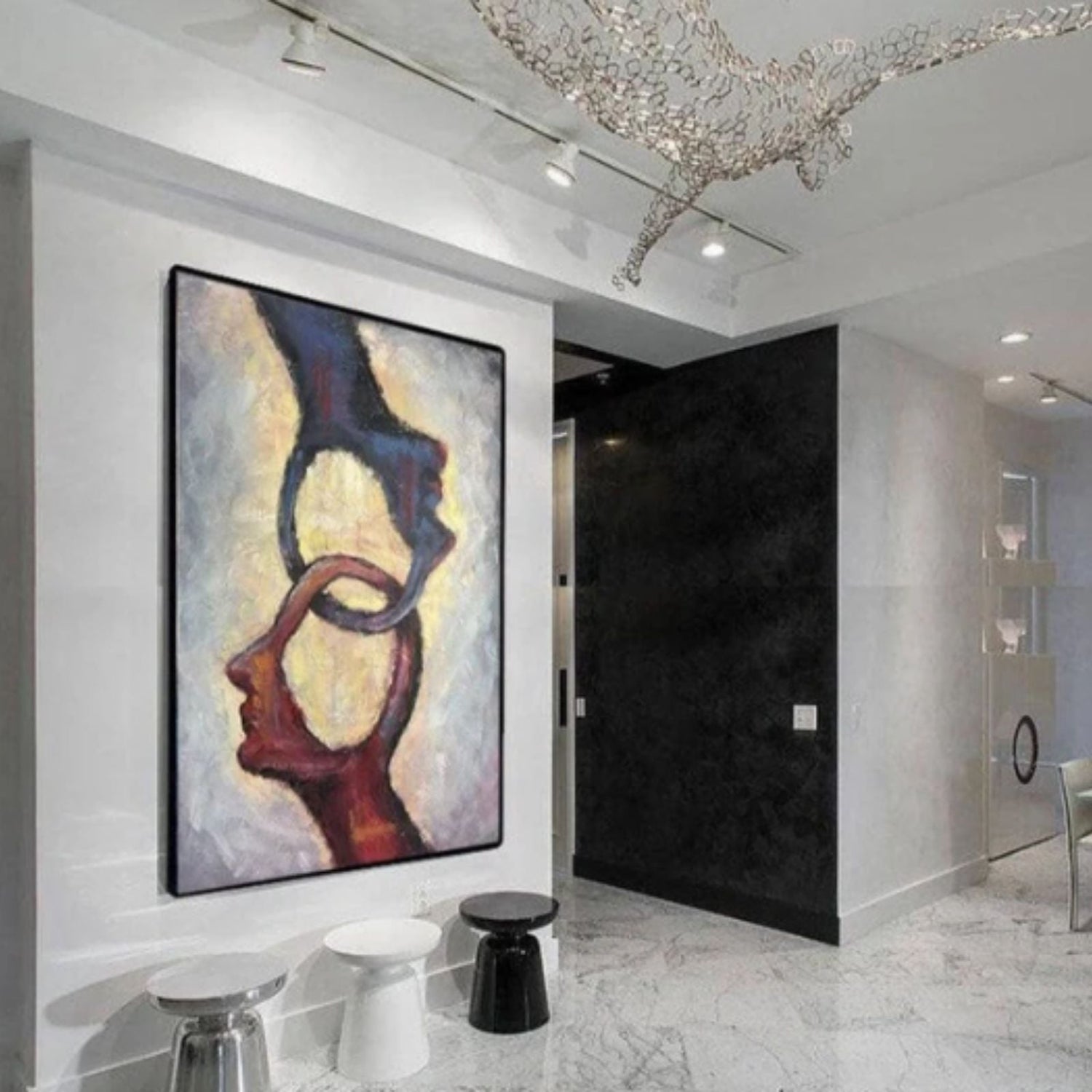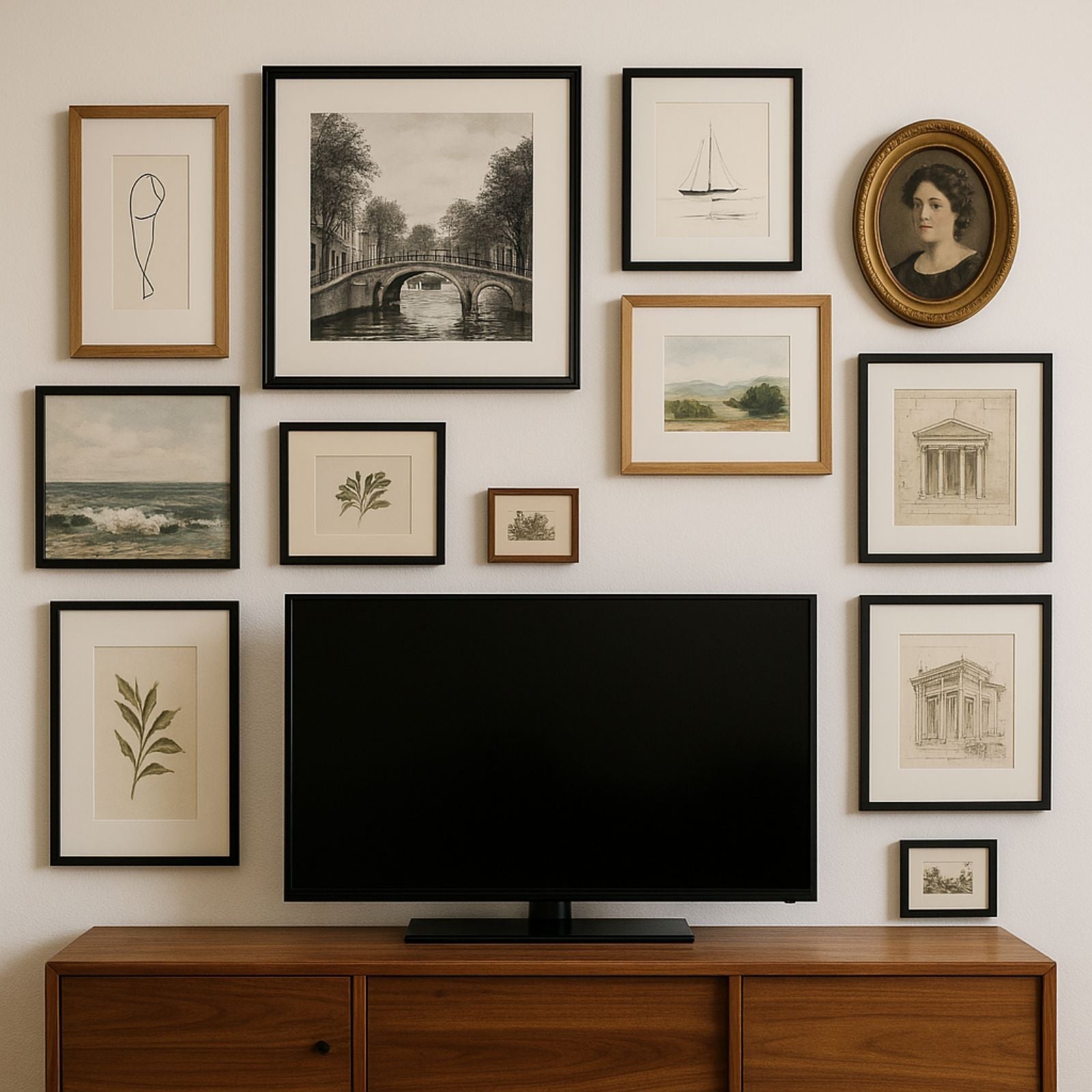Choosing art for the home is such a personal thing that often people get completely debilitated by it. The awareness that it’s an important and oftentimes expensive investment doesn’t help to make the decision any easier.
Sometimes, it feels easier to leave that gallery wall blank rather than hang art you’re lukewarm about. But it doesn’t have to be this way. We’d like to steer you in the right direction so you can realize your dream of having original artwork - and enjoy it for years to come.
Stop agonizing about choosing the right wall art. By following our trusted guidelines, you’ll be ready to hang your art in no time.
Just be yourself
It’s strange, isn’t it? That inner voice that tells us instinctively what we like and don’t like. You like orange, and not green. You like chicken but not fish. You like cold weather, not heat. It's like this knowledge is just sitting here, waiting for the moment when we need to make decisions.
We’re suggesting this is the starting point for choosing artwork according to your own personal style and tastes. It's not so much a question of: ‘What does this art display say about me as a person?’ but rather, ‘Will I feel a sense of connection with the piece every time I look at it?’
If you truly want to enjoy art pieces, this level of connection is necessary and only achieved when you’re willing to be true to what you like. Forget about whether it’s going to have future investment value (unless that’s your main goal), and just go with your gut instinct.
Get inspired
Galleries are wonderful places to find out what you like, but so are art fairs, small exhibitions by emerging artists, thrift shops, markets, and online galleries.
With so many options available, take some time to scout around and just enjoy how other people have expressed themselves. This will likely give you wonderful ideas about what you like because you’ll keep gravitating towards a certain style, medium, or artist.
Take pictures of what you like (if allowed), and then compare the images with the wall space you want to hang the piece of art and the furniture around it. At some point, you’re going to feel certainty settle in you, and you’ll be ready to make your purchase.

Be true to who you are, and inspiration will come
Your personal style
When you’re acquainted with what you like, you may have noticed you’re drawn to a particular look, technique, or medium. That’s good news because even if you haven’t found the piece you want, you’ll know what style of artwork you like. That will help you to narrow down your search.
Different styles of art are often categorized based on their visual characteristics, techniques, and historical movements. Here are some of the major styles:
|
Category |
Style |
Well-known artists |
|
Traditional or classic |
Realism Impressionism Expressionism Surrealism Neoclassicism |
Monet, Edvard Munch, Salvador Dalí, Rembrandt |
|
Modern and contemporary |
Minimalism Cubism Pop art Conceptual art |
Picasso, Braque, Warhol, Banksy, Lady Pink |
|
Decorative and mixed |
Art Deco Art Nouveau Futurism Op Art (Optical Art) |
Emile-Jacques Ruhlmann, Sonia Delaunay, Robert Falk, Bridget Riley |
Not only will the different styles evoke a personal connection (as discussed), but they also create different moods. Mood is an important consideration for the room or space in which you want to hang your art. For instance, a narrow space may already feel confined, and adding bold, modern contemporary pieces—often striking and dominant—could amplify this sense of restriction rather than enhance the space.
Mixing and matching styles
You don’t need to stick to just one style throughout your home. Combining styles can be fun, interesting, and creative. Here are a few ways you can mix styles effectively:
- Contrast old and new by pairing classical paintings with modern furnishings.
- Mix oil painting with photography or textile-based wall art for added dimension.
- Stick to one color palette, even if styles var,y because this will unify the space.
An original piece or a print?
It’s really great if you’re in a position to purchase an original, artist-certified work from a gallery. However, you shouldn’t feel pressured to do this. Inexpensive art with custom framing can be just as much of a delight as original art. Here are some differences between original art and prints to help you make a decision.
|
Original Artwork |
Prints |
|
Unique work, often with visible brushstrokes and textures |
A copy of an original artwork, made using printing techniques |
|
Oil, acrylic, watercolor, or mixed medium |
Unlimited copies (open print) or limited copies (signed by artist) |
|
More expensive but retains value over time |
More affordable than the original works |
|
Comes with a certificate of authenticity or artist signature |
Printed in various sizes and on different materials such as paper, canvas, or metal etc.) |
|
Will increase in value if the artist gains significant recognition |
Ideal for homes where you want to change the artwork regularly |
Looking for an alternative?
Innovative online gallery Paints Lab produces 100% hand-painted Canvas artwork at a fraction of the cost of an original painting. Their beautiful pieces bring uniqueness, colour, and vibrance to your room and are painted by a small group of artists who have dedicated themselves to making original canvas pieces available to the wider public.
Their collection features:
- Abstract Art: Bold, colorful compositions that energize any room.
- Minimalist Art: Clean, contemporary designs that bring a sense of calm.
- Graffiti Art: Vibrant, urban-inspired pieces with dynamic energy.
- Nature & Landscape: Stunning interpretations of natural scenes.
-
Custom Pieces: Have something special in mind? PaintsLab allows you to request custom artwork tailored to your style and space.

View the full Paints Lab Collection
Consider the space
Before you purchase your artwork, there are a few more considerations that could help you to finalize your decision. One of these considerations is space.
When selecting art, it’s important to evaluate the space where you’ll be displaying it. Each room in your home has a different purpose, and your choice of artwork should complement that purpose.
- Living room: This is generally the heart of the home, ideal for large statement pieces that set the tone for the space. Consider bold abstracts, landscapes, or portraits to make the living room the central area of your home.
- Bedroom: A personal sanctuary where calming, serene artwork works best. Soft watercolors, minimalist compositions, or romantic pieces fit well here.
- Kitchen: Often overlooked, but adding small prints, vintage posters, or food-inspired art can bring warmth and personality to the space.
- Hallways and entryways: These traditional spaces benefit from elongated pieces, gallery walls, or vertical artwork to create visual flow.
- Home office: Motivational, thought-provoking, or creative artwork can enhance focus and productivity. Abstract art, photography, or conceptual art work well.

The right size artwork
Your perfect piece should be the right size for the space in which you want to hang it. Whether you want a large piece or smaller pieces, there are general size guidelines. An artwork should not take up more than two-thirds to three-quarters of the available wall space. If placed above furniture, such as a couch or a bed, it should be about 60-75% of the width of the furniture below it.
Framing and Presentation
Framing can significantly impact how an artwork is perceived. Consider the following options to frame your art.
- Traditional frame: Classic wooden or metallic frames that suit realism, impressionism, or fine art pieces.
- Floating frames: Ideal for modern or contemporary works, giving the artwork a clean and sophisticated finish.
- Gallery wrap canvas: This works well for oversized pieces, lending a museum-like quality.
- Mixed-frame gallery walls: A curated collection of framed and unframed pieces for a dynamic display.
For existing artwork, you can get a quote from a frame shop or include framing in your purchase if you are buying the piece online or at a local gallery.
Watch and learn
How to Choose Art Like A Designer: Wall Art, Wall Décor and a Modern Gallery | Ashley Childers
In this video, Interior Designer Ashley Childers walks you through how to choose, frame, and hang wall art to create beautiful and sophisticated displays. She covers different categories of art, including canvas prints, photography, mirrors, and found objects, and advises mixing different types for an interesting look.
Alongside our tips for how to choose art for your home, Ashley’s video provides a comprehensive guide, making it easy for you to successfully decorate your home with beautiful and unique artwork.
Pricing and where to buy
Choosing art for your home doesn’t have to be a huge investment. The average person looking for an original artwork, high-quality print, or budget-friendly alternative will find something.
Have an amount in mind when you’re scouting around so that if you see a piece you love and are convinced you must have it, you know what you are willing to spend on it. Art can range from a few hundred dollars to millions, but most people fall into one of these categories:
- Budget-friendly: Ideal for prints, posters, digital downloads, and good art from emerging artists ($50-$500). At this level, you can also purchase original hand-painted canvas artwork from Paints Lab in small to medium sizes. Online marketplaces, thrift stores, and DIY art are also options.
- Mid-range: This category will include limited edition prints, small original pieces, and artworks from recognized artists. It will also include large canvases from online galleries like Paints Lab ($500-$5,000). Art fairs, direct-from-artist, and small galleries will also fall under this price range.
- High-end: Covers large original artworks and commissioned pieces, or investment-grade art ($5,000+). Buy this level of art at exclusive galleries, at art auctions, and directly from artists.
When planning your budget, include money for framing and shipping costs. Some galleries will include free shipping when you purchase their artwork. This add-on service is especially valuable when you’re purchasing a canvas from an online gallery and it is being shipped internationally.
Go ahead and hang your art!
After making this decision and ordering your art, don’t let it sit in the corner of the room, waiting to be hung - we won’t say this hasn’t happened before to people. In fact, if you’re not excited to get this on your wall the minute it arrives, then you’ve probably purchased something you’re lukewarm about. Don’t let this happen - review the guidelines we’ve provided and purchase an artwork you can be committed to.
It all begins with being yourself and noticing what you’re inspired by. After this, there’s not a lot that can go wrong. But, if you’re looking for expert advice and want to run your ideas past someone, send the Paints Lab team a message - they’re ready to help you pick out an artwork you can be proud of.




Leave a comment
This site is protected by hCaptcha and the hCaptcha Privacy Policy and Terms of Service apply.